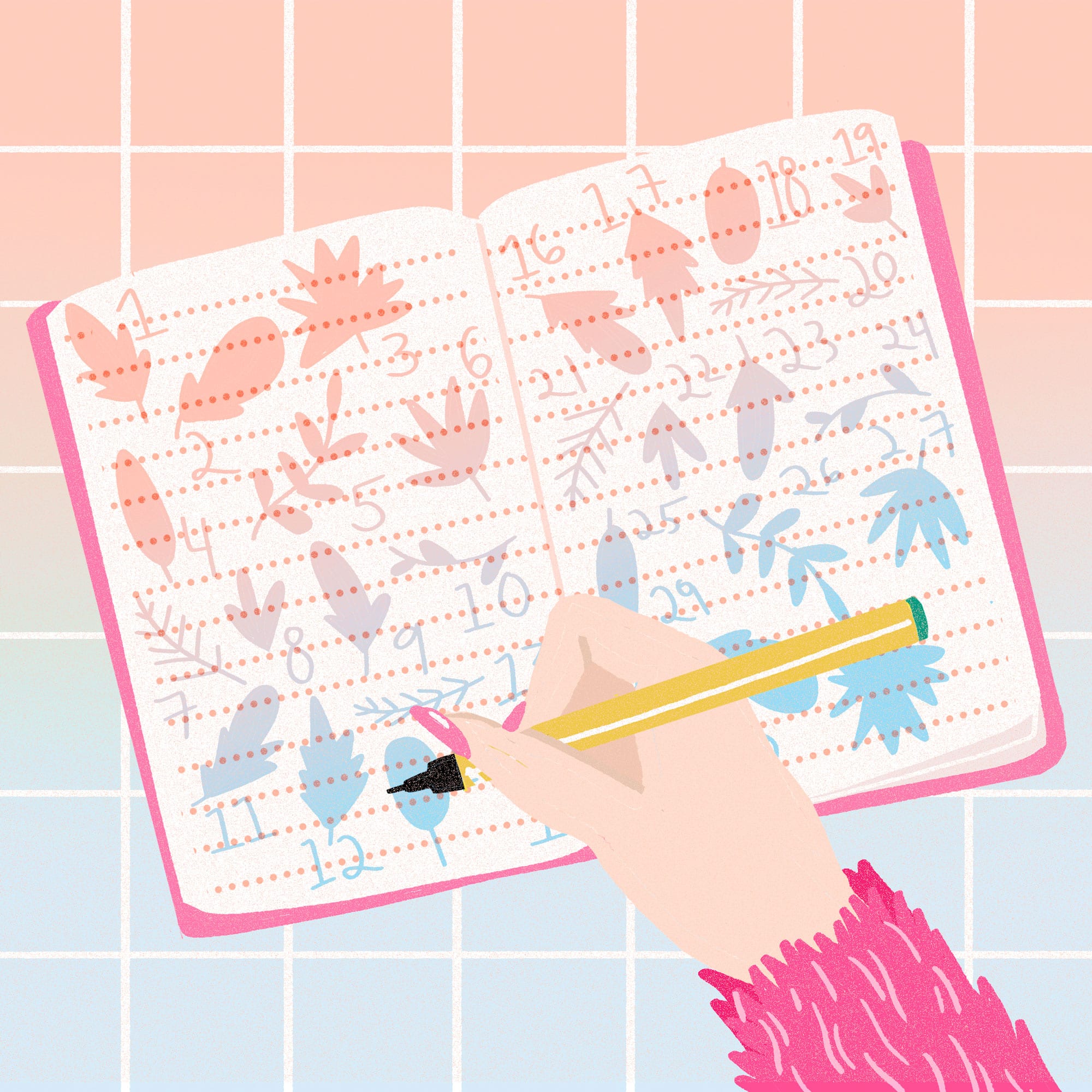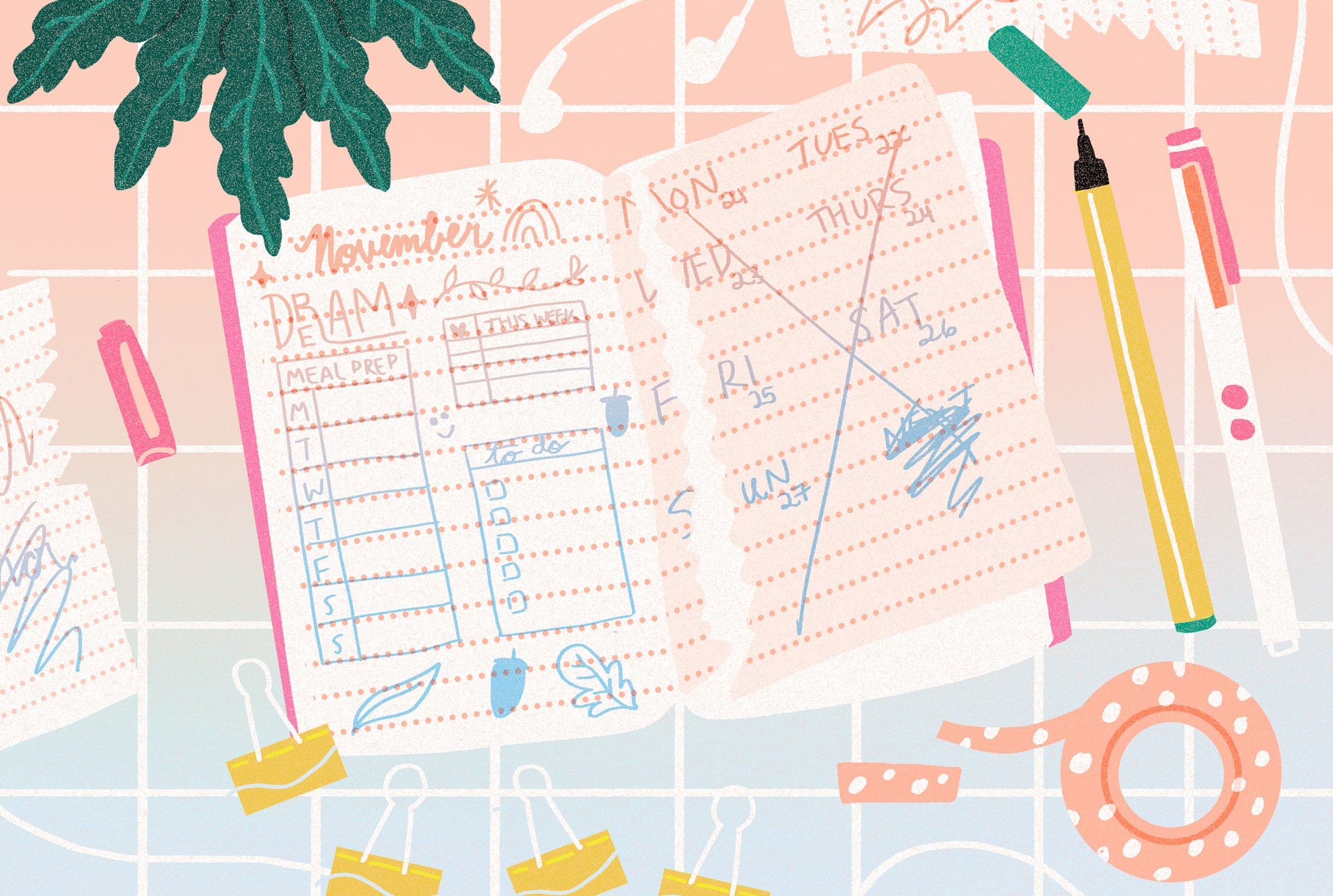I am already stressed out, and I haven’t even made it to Target yet. I am sitting at my desk, googling how to start a bullet journal. I should start by saying I am a skeptic. My unfinished adult coloring books sit in the corner, a mocking gesture of my previous task for my anxiety. So, I question how one notebook can make my life more meaningful. Even the name stresses me out: the bullet journal.
But, with 18.1 percent of the American population suffering from anxiety disorders every year, and bullet journals toted as a unique form of coping with anxiety, I decided to give it a try. It’s 2018, after all, where wellness and self-care are circling the globe, and everyone plans out their next accomplishments.
“I keep staring at my ruined Index page, overwhelmed with the stress this intimate object is going to cause me.”
The bullet journal was born out of the need to stay productive. Ryder Carroll, digital product designer and author, was diagnosed early in life with learning disabilities. With no outlet and his desire for productivity, Carroll devised a new method, which he coined the “Bullet Journal.” It is his approach to intentional living, in an age where we are consumed by all things digital and tend to lead a distracted life instead of a purposeful one.
And, with intentional living comes the return to the basics: handwriting. It has been proven that handwriting is beneficial for your brain. It works to engage the mind, which is why studies have shown that handwriting is preferred for everything from taking class notes to doodling. In an era where our phones are glued to our hands, bullet journaling is a way to activate our minds by writing down exactly what is important to us.
So, here I am staring at beautiful watercolor and perfectly calligraphed bullet journals — there are over two million tags under #bulletjournal on Instagram — determined to get things going.
Adamant to do this by the book (no pun intended), I go to Carroll’s website to learn from the creator himself how to layout and organize my bullet journal. I decide on this task, my journal will be a dotted notebook, which according to Carroll is supposed to give you the flexibility to create your visions. I am on the hunt for the Leuchtturm1917 journal, but there must be a run on bullet journals because it takes me two stops to procure a dotted notebook. Thankfully, I managed to snag the last one, an Exceed notebook, in a happy yellow.
Staring at my newly acquired journal with hesitation and, I admit, excitement, I prep myself for the task ahead. The first step in any bullet journal is to layout your Index. I can’t emphasize enough how important these first few pages will be, especially if you find yourself an avid journaler. Simply leave three to four pages free upfront, and you can catalogue each page of your journal for when you need to find that budget guide at a moment’s notice, without flipping through hundreds of pages.
I pick up the pen to start my Index, and I already make my first mistake. My pen of choice bleeds through onto the next page. I force myself to take a breather, but I am done for the night, as I keep staring at my ruined Index page, overwhelmed with the stress this intimate object is going to cause me. The excitement is gone.
Everyone at work points out that this is supposed to be a fun activity, a way to gauge if the trend actually works. But I can’t seem to keep myself from flipping back to that first page, staring at my mistake.
 Attempting to place my perfectionism on the back burner, I pull up Carroll’s instructions again, and I move on. What follows are the Future Log, Monthly Log and Daily Log.
Attempting to place my perfectionism on the back burner, I pull up Carroll’s instructions again, and I move on. What follows are the Future Log, Monthly Log and Daily Log.
The Future Log showcases your next six or so months and allows you to outline, well, your future. Simple enough.
The Monthly Log is the next spread, with a calendar page (left) facing a task page (right). The calendar acts exactly like that, a calendar, but the task page is to jot down anything and everything for the month that needs accomplishing, e.g. schedule that doctor appointment, pay rent and register to vote.
Next, comes the Daily Log with rapid-fire lists of everything you need to do, notes and goals for the day. Follow Carroll’s key to rapid logging to maximize the journal benefits.
As I trace out my daily log, I wish, for the millionth time, that I was good at art. It is clear to me that you don’t have to be artistic to have a bullet journal. There is no art requirement you have to meet to organize your life. If all you have is a ballpoint pen and paper, you will be fine. With that said, it definitely helps.
My coworker recently told me that my bullet journal journey had inspired her to try it out. With as much gusto as I’ve seen recently, she left work that day a determined woman. After researching the best of the best, she walked away from the store with her bullet journal and $30 worth of supplies. Two hours later I received a text. She ripped out a whole page from her journal and admitted I was right, this is kind of hard.
Staring at her ripped out the page, I feel the urge to beat this journal that is currently knocking me, and her, down. So, I decided to create what Carroll calls a Custom Collection, which gives you the opportunity to branch out from strictly scheduling into a creative mindset. I choose to track my moods, to see if this task is having the desired effect on my life. But I don’t want to just make a chart. I want to make it beautiful.
 It all comes down to a leaf — a leaf for each day of October (it is fall, after all). In my mind, it is my artistic debut, making my journal worthy of #greatness, but first I have to get over the hump: drawing it out. I pick up my pencil (I haven’t graduated to freehand yet), and I sit for two hours and draw 31 leaves, which I then trace over with my pen. I should probably be embarrassed by the joy I felt once I completed this task. But, I don’t. My October mood board is delightful, and for the first time, I am excited about my journal.
It all comes down to a leaf — a leaf for each day of October (it is fall, after all). In my mind, it is my artistic debut, making my journal worthy of #greatness, but first I have to get over the hump: drawing it out. I pick up my pencil (I haven’t graduated to freehand yet), and I sit for two hours and draw 31 leaves, which I then trace over with my pen. I should probably be embarrassed by the joy I felt once I completed this task. But, I don’t. My October mood board is delightful, and for the first time, I am excited about my journal.
It is then, that I sit and really look at the journal I’ve begun to create. And, to my surprise, I have actually been using it. I must admit, it is convenient to have my social calendar, work calendar, to-do list and notes all in one place, especially since they typically function within each other.
I have read many success stories at this point. People noting that it is okay to be imperfect, that every stroke here and crossed out a word there, tells a story of how you live your life. But, for me, I do not see the bullet journal as a sustainable task.
After I fill in that last leaf on Oct. 31, will I keep using it? Probably not. It will join that pile of abandoned adult coloring books. While bullet journaling has been a proven tool for people that experience anxiety, it does not work for me. Yes, it kept me organized, but the desire for it to be perfect was overwhelming, and it did not dissipate with use. This will not be a long bullet journal adventure, but it was an adventure I am glad I tried out.
Here are some tips from me to you, should you begin your own bullet journal quest:
- Plan before you start. It might seem like a waste of time, but you’ll thank yourself in the long run.
- Trust me, you don’t need the most expensive notebook out there. But the dot layout is a must.
- You really only need one pen, but feel free to be as extra or as minimal as you want. It is your journal, after all.
- With that being said, do not use a Sharpie pen, it will bleed through. (See a small breakdown over my Index above.)
- Rulers are your friends!
- Turn to Instagram for inspiration. Some of my favorite accounts are @my.life.in.a.bullet, @bulletjournal and @boho.berry.
- Use this time to learn about yourself, you might be shocked by what you discover.
We only recommend products we have independently researched, tested, and loved. If you purchase a product found through our links, Sunday Edit may earn an affiliate commission.







